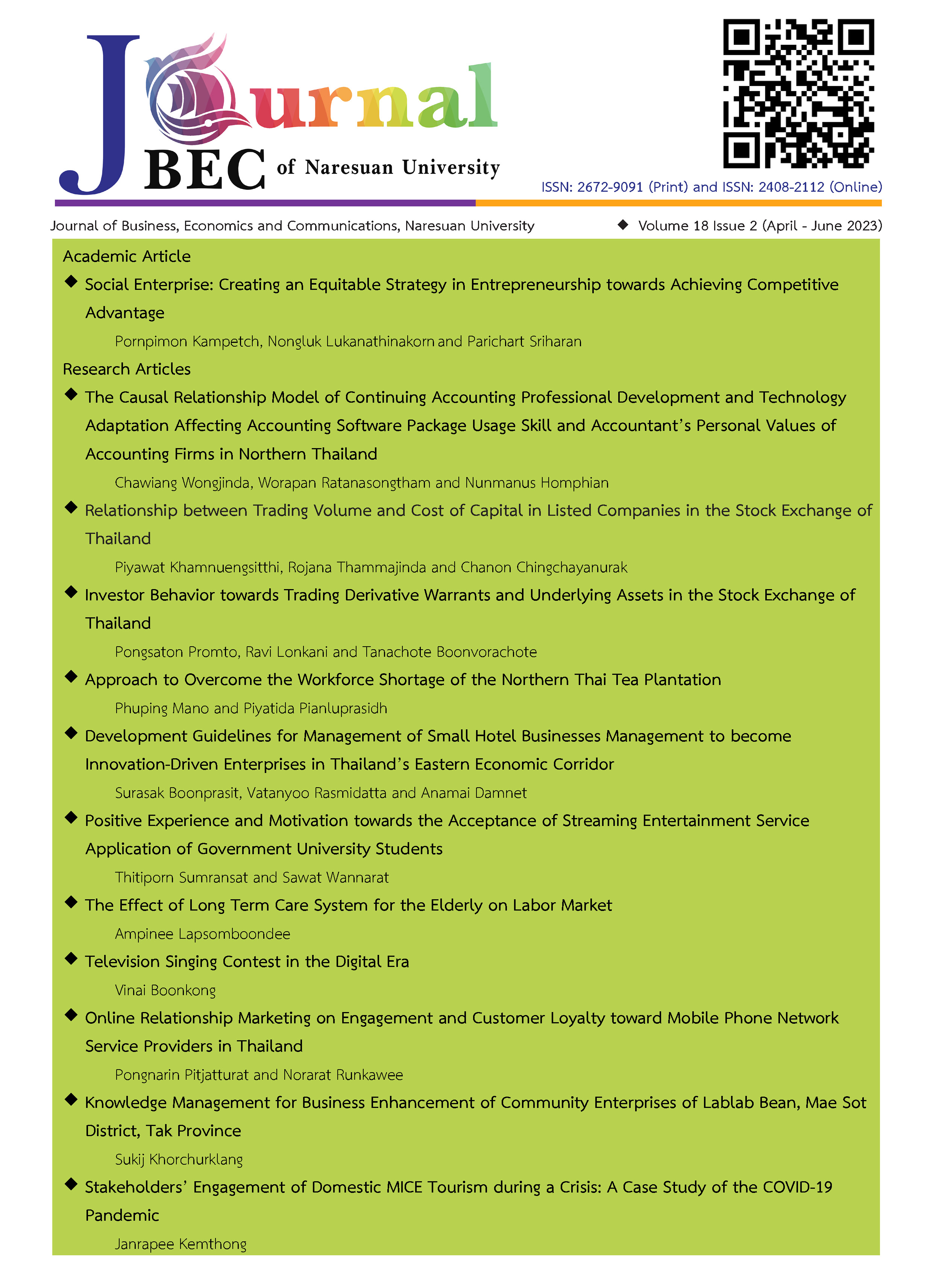Investor Behavior towards Trading Derivative Warrants and Underlying Assets in the Stock Exchange of Thailand
Main Article Content
บทคัดย่อ
Derivative warrant order imbalance causes market makers to hedge their inventory risk by purchasing the underlying stock at delta quantities. As a result, the information on the derivative warrant trading imbalance transmits to the underlying stock. To study the effect of information, this research has divided the trading imbalance into the order imbalance of derivative warrants and the order imbalance of underlying assets. The result shows that derivative warrants order imbalance can carry information to the underlying stock and causes the underlying price readjustment in the next day. However, the underlying asset order imbalance reveals only the effect of price pressure. When analyzing the intraday transaction, the derivative warrants show a positive correlation to the underlying asset return over the next 30 minutes of any interval. Thus, this research concludes that the derivative warrants trading comprised of informative trading which reduces the information asymmetry.
Article Details

อนุญาตภายใต้เงื่อนไข Creative Commons Attribution-NonCommercial-NoDerivatives 4.0 International License.
เอกสารอ้างอิง
Anatolyev, S. and Mikusheva, A. (2022). Factor models with many assets: strong factors, weak factors, and the two-pass procedure. Journal of Econometrics, 229(1), 103-126.
Avramov, D., Chordia, T., and Goyal, A. (2006). Liquidity and Autocorrelations in Individual Stock Returns. Journal of Finance, 61(5), 2365-2394.
Baltussen, G., Da, Z., Lammers, S. and Martin, M. (2021). Hedging demand and market intraday momentum. Journal of Financial Economics, 142(1), 377–403.
Black, F. (1975). Fact and Fantasy In the Use of Options. Financial Analysts Journal, 31(4), 36-41.
Black, F. and Scholes,M. (1973).The pricing of options and corporate liabilities. Journal of Political Economy, 81(3), 637–654.
Blanco, I. and Gracia, A. (2021). Options trading and the cost of debt. Journal of Corporate Finance, 69(August), 1-17.
Boonvorachote, T. (2008). What is Market Microstructure?. Retrieved March 11,2018, from https://media.set.or.th/set/Documents/2022/Jan/01_what_is_market_microstructure.pdf
Chang, C. C., Hsieh, P. F. and Lai H. N. (2009). Do informed option investors predict stock returns? Evidence from the Taiwan stock exchange. Journal of Banking & Finance, 33, 757–764.
Chordia, T., Roll, R. and Subrahmanyam, A. (2002). Order imbalance, liquidity, and market returns. Journal of Financial Economics, 65(1), 111–130.
Chordia, T. and Subrahmanyam, A. (2004).Order imbalance and individual stock returns: Theory and evidence. Journal of Financial Economics, 72(3), 485-518.
Easley, D. and O'hara, M. (1987). Price, Trade Size, and Information in Securities Markets. Journal of Financial Economics, 19(1), 69-90.
Easley, D., O’Hara, M. and Srinivas, P. S. (1998). Evidence on Where Informed Traders Trade. Journal of Finance, 53(2), 431-465.
Garvey, R., Huang, T. and Wu, F. (2017). Why Do Traders Split Orders?. The Financial Review, 52(2), 233–258.
Gilstrap, C., Petkevich, A. and Teterin, P. (2020). Striking up with the in crowd: When option markets and insiders agree. Journal of Banking and Finance, 120, 1-22.
Holowczak, R., Hu, J. and Wu, L. (2014). Aggregating information in option transactions. Journal of Derivatives, 21(3), 9-23.
Hu, J. (2014). Does option trading convey stock price information?. Journal of Financial Economics, 111(3), 625–645.
Lee, C. M. C. and Ready, M. J. (1991). Inferring trade direction from intraday data. Journal of Finance, 46(2), 733–746.
Lee, M. and Chen, C. D. (2004). The intraday behaviors and relationships with its underlying assets: Evidence on option market in Taiwan. International Review of Financial Analysis, 14(5), 587–603.
Narayan, P. K., Narayan, S. and Westerlundac, J. (2015). Do order imbalances predict Chinese stock returns ? . New evidence from intraday data. Pacific-Basin Finance Journal, 34, 136-151.
Pan, J. and Poteshman, A.M. (2006). The Information in Option Volume for Future Stock Prices. The Review of Financial Studies, 19(3), 871-908.
Patel, V., Putnins, T., Michayluk, D. and Foley, S. (2020). Price discovery in stock and options markets. Journal of Financial Markets, 47, 1-28.
Roll, R., Schwartz, E. and Subrahmanyam, A. (2010). O/S: The relative trading activity in options and stock. Journal of Financial Economics, 96(1), 1-17.
Smales, L. A. (2012). Order imbalance, market returns and macroeconomic news: Evidence from the Australian interest rate futures market. Research in International Business and Finance, 26(3), 410-427.
Tanthanongsakkun, S., Treepongkaruna, S., Wee, M. and Brooks, R. (2018). The Effect of Trading by Different Trader Typeson Realized Volatility and Jumps: Evidence from the Thai Stock Market. Chulalongkorn Business Review, 40(158), 111-142.
Tripathi, A., Dixit, A. and Vipul (2021). Information content of order imbalance in an order-driven market:Indian Evidence. Finance Research Letters, 41, 1-10.
Zhang, T., Jiang, G. J. and Zhou, W. (2021). Order imbalance and stock returns: New evidence from the Chinese stock market. Accounting & Finance, 61(2), 2809-2836.
Zhou, Y. (2022). Option trading volume by moneyness, firm fundamentals, and expected stock returns. Journal of Financial Markets, 58, 1-36.


